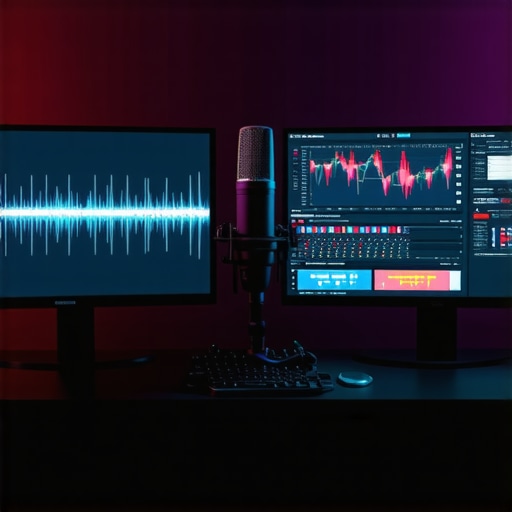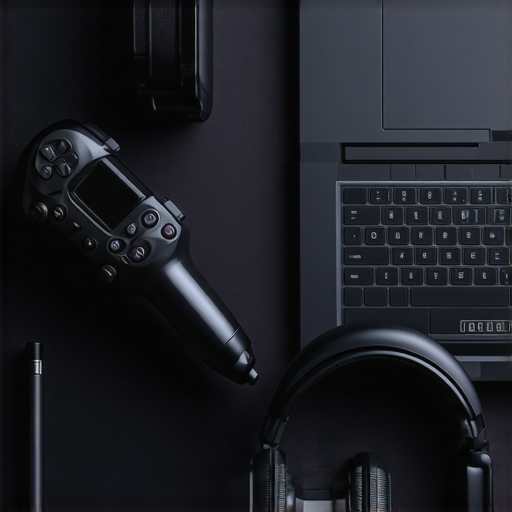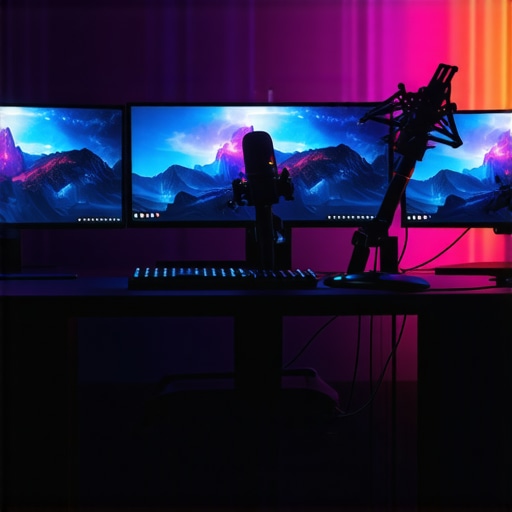My Journey into the World of Live Game Streaming
Just a few years ago, I was an avid gamer who dreamed of sharing my passion live with an online audience. I remember the first time I set up my streaming station, fumbling with outdated gear and wondering why my streams looked so amateurish. Since then, I’ve invested in the best streaming equipment, and I want to share what’s essential for achieving professional-quality live game streams in 2024.
Why High-Quality Streaming Equipment Matters More Than Ever
In the competitive world of game streaming, your equipment is your foundation. Clear visuals, crisp audio, and smooth performance can make or break your viewer retention. As someone who’s experienced both the frustrations of laggy streams and the thrill of seamless broadcasts, I can attest that investing in the right gear truly elevates your streaming game.
Must-Have Streaming Gear to Level Up Your Game
1. The Perfect Capture Card: How Do I Choose?
For me, a reliable capture card like the Elgato 4K60 Pro was a game-changer. It lets me record and stream in high resolution with minimal latency. When choosing a capture card, consider compatibility with your PC or console, resolution support, and streaming features.
2. The Best Microphone for Crystal Clear Voice
Good audio is crucial. I switched from a basic headset mic to a USB condenser microphone like the Shure SM7B. It dramatically improved my sound quality and reduced background noise, making my commentary more professional and engaging.
3. Lighting That Sets the Mood
Good lighting can dramatically enhance your stream’s visual appeal. I use adjustable LED panels that provide even, soft light. It’s amazing how much better your camera looks with proper lighting, especially in darker rooms.
What About Streaming Software and Internet Speed?
Of course, a powerful computer with a fast internet connection is essential. I personally rely on OBS Studio for streaming because of its versatility and open-source nature. My internet speed hovers around 100 Mbps, which ensures my stream remains smooth and buffer-free even during intense gaming moments.
How Do I Balance Quality and System Performance?
It’s a balancing act. I’ve learned to tweak settings like bitrate, resolution, and frame rate based on my hardware capabilities. External tools and detailed guides, like those from TechRadar, help me optimize my stream without overloading my system.
If you’re serious about streaming in 2024, investing in quality equipment is the first step toward creating captivating, professional streams. I invite you to share your experiences or ask questions in the comments—let’s grow our streaming skills together!
Enhancing Your Stream’s Visuals: What Are the Hidden Gems in Lighting and Backgrounds?
While many streamers focus on equipment and internet speed, visual aesthetics often take a backseat. As an expert, I’ve learned that subtle lighting adjustments and thoughtfully curated backgrounds can dramatically boost viewer engagement. Using RGB lighting to create mood or focus on specific areas of your setup can lead to more dynamic streams. For instance, soft backlighting behind your gaming area adds depth and reduces harsh shadows, making your video appear more professional. Additionally, a clean, themed background or branded overlays lend credibility and help reinforce your personal brand, making your stream instantly recognizable.
How Can Advanced Audio Techniques Elevate Your Streaming Presence?
Beyond choosing a high-quality microphone, integrating audio processing tools like noise gates and compressors ensures your voice remains clear and consistent. I recommend exploring software plugins that automatically filter out background noise and optimize voice clarity, even in noisy environments. Additionally, using external audio interfaces can provide more control over sound quality, allowing you to fine-tune your audio settings in real time. For example, blending ambient sounds or game audio with your commentary can create a more immersive experience, prompting viewers to stay longer and engage more actively.
What Are the Nuances of Stream Optimization for Different Platforms?
Streaming across platforms like Twitch, YouTube, or Facebook Live requires nuanced adjustments to your settings. Each platform has preferred codecs, bitrates, and resolution settings that impact quality and performance. For instance, Twitch recommends a maximum bitrate of 6000 Kbps for 1080p streams, but this can vary depending on your internet stability. I’ve found that customizing your encoding presets based on the platform’s guidelines — and your hardware capabilities — results in smoother streams and fewer technical issues. Consult the official streaming platform documentation or community forums, like those from Streamers Haven, to stay updated with the latest best practices.
Are You Overlooking the Impact of Stream Analytics and Feedback?
Analyzing your stream data and viewer feedback can be transformative. Tools like TwitchTracker provide insights into viewer engagement, peak times, and quality metrics. Regularly reviewing this data helps identify technical bottlenecks or content preferences. Moreover, actively engaging with your community through comments or polls to ask what they like about your stream fosters loyalty and guides future improvements. As an expert, I’ve seen firsthand how continuous feedback loops and data-driven adjustments lead to sustained growth and a more professional streaming presence.
If you’re eager to push your streaming skills further, consider exploring advanced tutorials on image processing or audio engineering. Sharing your experiences or questions in the comments can spark invaluable advice from fellow creators—let’s keep the conversation going and elevate our streaming craft together!

Delving into the Art of Visual Storytelling Through Lighting and Backgrounds
Over the years, I’ve realized that the visual aspect of streaming isn’t just about having high-quality cameras or fancy overlays; it’s about creating an immersive environment that tells your story. I remember experimenting with different lighting setups—playing with color temperatures and angles—and discovering how subtle shifts could dramatically change the mood of my stream. For example, soft backlighting with RGB LEDs behind my gaming setup added depth, making my camera feed more engaging and less flat. Curating a background that reflects your personality or theme—whether it’s a clean, minimalist space or a vibrant, themed backdrop—can forge a stronger connection with viewers. It’s these nuanced choices that elevate a stream from amateur to professional, inviting viewers into your world rather than just watching from the sidelines.
Harnessing Advanced Audio Processing for a Richer Listening Experience
While I initially relied on a good microphone, I soon began exploring sophisticated audio techniques to refine my broadcast. Using tools like noise gates, compressors, and equalizers, I learned to craft a balanced, professional sound. For instance, I set up a noise gate to eliminate background hum when I’m not speaking, and a compressor to keep my voice level consistent—even during moments of excitement. Integrating plugins such as iZotope Nectar or Waves’ plugins, I was able to further enhance clarity and warmth. Additionally, blending ambient sounds or game audio with my commentary, rather than having them compete, created an immersive atmosphere that captivated viewers. These small but impactful adjustments made my streams feel more polished and engaging, encouraging longer watch times and more interaction.
What Are the Deep Technical Considerations for Multistreaming Without Compromising Quality?
Streaming across multiple platforms like Twitch, YouTube, and Facebook simultaneously introduces complex challenges. Each platform has its preferred codecs, bitrates, and resolution settings, which can conflict or overload your system if not managed carefully. I’ve learned that using software like Restream.io or Streamlabs Multistream allows me to distribute my signal efficiently, but I still need to fine-tune settings for each destination. For example, Twitch favors a maximum bitrate of 6000 Kbps for 1080p streams, but YouTube supports higher bitrates and resolutions. Balancing these requirements while maintaining a stable connection demands a strategic approach—adjusting key parameters, monitoring real-time analytics, and being ready to troubleshoot latency issues. According to Streaming Media, understanding the platform-specific encoding nuances and network conditions is crucial for delivering top-quality streams across all channels simultaneously.
How Do I Use Data and Feedback to Continuously Refine My Stream Quality?
One of the most overlooked aspects of professional streaming is the value of analytics and viewer feedback. I regularly review data from TwitchTracker and StreamElements to analyze peak viewership times, engagement rates, and technical issues. Actively soliciting feedback through polls or direct comments helps me understand what resonates most with my audience. For example, after noticing that viewers preferred my gameplay segments with more visual effects, I incorporated overlays and transitions that enhanced the viewing experience. This iterative process—combining data insights with community input—has been pivotal in evolving my stream’s quality and professionalism. It transforms passive broadcasting into a dynamic conversation, fostering loyalty and trust. If you’re serious about leveling up, I encourage you to explore advanced tools like OBS Studio’s analytics plugins or third-party apps that visualize viewer engagement, providing actionable insights to guide your content development.
If you’re eager to deepen your mastery of streaming, consider exploring tutorials on advanced image processing or audio engineering. Sharing your journey and insights in the comments can spark valuable exchanges—after all, we’re all continuously learning and growing as creators. Let’s push the boundaries of what’s possible in live game streaming together!
Refining Your Visual Aesthetics with Dynamic Lighting and Personal Branding
Over the years, I’ve come to appreciate how subtle lighting adjustments can transform the aesthetic appeal of a stream. Experimenting with RGB backlighting and adjustable color temperatures allows me to create a mood that resonates with my content theme, whether it’s a vibrant, energetic vibe or a subdued, focused atmosphere. Beyond lighting, my background setup—featuring personalized decor and branded overlays—serves as a visual signature that fosters a deeper connection with my viewers. Incorporating seamless transitions and thematic elements not only enhances professionalism but also reinforces brand identity, making your stream instantly recognizable in a crowded digital landscape.
Leveraging Sophisticated Audio Processing for Immersive Engagement
Transitioning from basic microphone setups to advanced audio processing has been pivotal in elevating my streaming quality. Employing tools like iZotope Nectar or Waves plugins, I fine-tune my voice with equalization, compression, and noise suppression, ensuring clarity and warmth. Setting up external audio interfaces grants me granular control over sound levels, enabling real-time adjustments that adapt to different scenarios. Additionally, blending ambient sounds and game audio with commentary creates an immersive environment that captivates viewers—imagine a subtle background score that complements gameplay, making the experience more engaging. These meticulous audio techniques contribute significantly to a polished, professional streaming presence.
How Do I Optimize Multistreaming Without Sacrificing Quality?
Multistreaming across platforms like Twitch, YouTube, and Facebook introduces complex technical challenges. Each platform has preferred codecs, recommended bitrates, and resolution standards, which can conflict or strain your system if not managed carefully. Utilizing tools like Restream.io enables efficient distribution of your stream, but fine-tuning remains essential. I focus on customizing encoding presets, balancing bitrate and resolution, and monitoring real-time analytics to ensure stability. According to Streaming Media, understanding platform-specific encoding nuances and network conditions is crucial for delivering consistent, high-quality streams across multiple channels. This strategic approach minimizes lag and buffering, maximizing viewer satisfaction and engagement.
What Are the Best Practices for Analyzing Viewer Data to Enhance Stream Quality?
Regularly reviewing analytics from tools like TwitchTracker and StreamElements provides invaluable insights into peak viewership times, engagement metrics, and technical performance. I actively solicit feedback through polls and direct comments, which help identify what content resonates most. For example, noticing increased engagement during gameplay with visual effects prompted me to incorporate overlays and transitions that further captivate my audience. This continuous loop of data-driven adjustments and community feedback transforms passive broadcasting into a dynamic interaction, fostering loyalty and elevating overall stream professionalism. Implementing analytics plugins within OBS Studio or third-party visualization tools allows me to refine my content strategy effectively.
If you’re serious about elevating your streaming craft, I encourage exploring advanced tutorials on image processing and audio engineering. Sharing your insights and questions in the comments not only enriches your growth but also builds a community of passionate creators eager to push streaming boundaries together.
Things I Wish I Knew Earlier (or You Might Find Surprising)
The Power of Lighting Beyond Equipment
When I first started streaming, I underestimated how much lighting could influence my visual storytelling. It’s not just about having a good camera; subtle lighting tweaks—like RGB backlighting or soft diffused lights—can dramatically change the mood and engagement level of your stream. I remember spending hours adjusting my setup, only to realize that a simple change in background lighting made my stream look more professional and inviting.
The Hidden Impact of Audio Quality
I used to think that a decent headset microphone was enough, but I quickly learned that investing in external audio interfaces and noise suppression tools significantly enhances clarity. I recall a stream where my voice sounded warm and consistent, and my viewers complimented the professional feel. Good audio isn’t just a technical detail; it’s a crucial part of storytelling that keeps viewers immersed.
Multistreaming Is a Double-Edged Sword
Trying to go live on multiple platforms simultaneously seemed like a great idea, but I faced unexpected technical challenges. Each platform has its preferred settings, and managing multiple streams without sacrificing quality requires strategic adjustments and reliable tools like Restream.io. It’s a balancing act, but mastering it pays off in increased reach and engagement.
Data-Driven Improvements Make a Difference
Regularly reviewing viewer analytics and feedback transformed my streaming approach. Tools like TwitchTracker provided insights into peak times and content preferences, guiding me to refine my content and technical setup. Engaging with viewers through polls and comments fostered a sense of community and helped me adapt faster.
Visual Aesthetics Are More Than Decoration
Thoughtful background setup and personalized branding elements make your stream memorable. I experimented with different themes and overlays, discovering that a clean, consistent visual identity helps in building a loyal audience. Small details—like background decor or customized overlays—can create a professional vibe effortlessly.
Resources I’ve Come to Trust Over Time
- OBS Studio: This free and versatile streaming software has been my go-to for customizing my broadcasts. Its open-source nature and active community mean I always find new tips and plugins to enhance my streams.
- StreamElements: A comprehensive platform for overlays, alerts, and chat management. It’s trustworthy and simplifies integrating branding elements seamlessly.
- TechRadar: Their in-depth guides on streaming hardware and software have helped me make informed decisions about equipment upgrades and settings.
- Streamers Haven Blog: A treasure trove of tips shared by experienced streamers, perfect for staying updated on best practices and emerging trends.
Parting Thoughts from My Perspective
Reflecting on my journey into professional live game streaming, I realize that the combination of quality equipment, thoughtful visual and audio design, and continuous learning truly elevates your content. These elements, coupled with a data-driven mindset and a genuine connection with your audience, make all the difference. If you’re serious about making your mark in 2024, remember that it’s not just about the gear—it’s about creating an authentic, engaging experience that resonates with viewers. So, keep experimenting, stay curious, and don’t hesitate to share your progress or questions. I’d love to hear your story and help you grow as a streamer. Feel free to drop your experiences in the comments or share this article with someone who’s ready to level up their streaming game.”,

